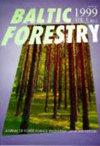Understory changes in mixed elm stands in response to canopy dieback in Latvia
IF 0.6
4区 农林科学
Q3 FORESTRY
引用次数: 0
Abstract
In the eastern Baltic region, warming is favouring the advance of thermophilic tree species and the formation of mixed stands with a higher share of broadleaves, thus contributing to productivity and other ecosystem services of forests. However, the accelerating environmental changes often trigger the spread and intensification of biotic disturbances such as disease outbreaks at unprecedented rates, which might alter the course of stand development. Within the region, elms (Ulmus sp.), which are of low importance as a source of timber, yet highly important in terms of other ecosystem services, are suffering varying degree of dieback due to the Dutch elm disease, which can threaten the existence of species. Still, there are explicit local differences in the susceptibility of trees, which add uncertainties regarding the sustainability of elms. A permanent sampling plot network was established to monitor changes in mixed elms stands in response to the dieback caused by the disease; canopy and understory trees were accounted. Two surveys in 2016 and 2021 have been made. Canopy elms have suffered moderate dieback during the first wave already before the surveys, as ca. 17% of canopy elms were already dead. However, the susceptibility differed among the species (Ulmus glabra exceeded U. laevis), likely due to the preference of the vectors of the disease. In response to canopy openings, self-regeneration occurred, though the balance between the advance regeneration and undergrowth species was affected by the intensity of canopy dieback. The advanced growth of the former canopy species including elms was sufficient under moderate changes in the canopy, while low and high changes favoured undergrowth, suggesting the formation of shrubland. Accordingly, the additional mortality of elms due to Dutch elm disease tended to diverge the development course of the mixed broadleaved stands; hence further monitoring is advised. Keywords: Ulmus sp., Ophiostoma sp., advance growth, undergrowth, Dutch elm disease, succession拉脱维亚榆树混交林树冠枯死后的林下变化
在波罗的海东部地区,气候变暖有利于喜热树种的生长,形成了阔叶较多的混交林,从而促进了森林的生产力和其他生态系统服务。然而,加速的环境变化往往以前所未有的速度引发诸如疾病爆发等生物干扰的蔓延和加剧,这可能改变林分发展的进程。在该地区,榆树(Ulmus sp.)作为木材来源的重要性不高,但在其他生态系统服务方面却非常重要,由于荷兰榆树病,这些榆树正在遭受不同程度的枯死,这可能威胁到物种的存在。然而,树木的易感性存在明显的地方差异,这增加了榆树可持续性的不确定性。建立了永久性样地网络,监测混合榆林因病害引起的枯死而发生的变化;计算了冠层和林下乔木。2016年和2021年进行了两次调查。在调查之前,榆树在第一波中已经遭受了中度枯死,大约17%的榆树已经死亡。然而,不同物种之间的易感性存在差异(秃榆高于 秃榆),可能是由于疾病媒介的偏好所致。在林冠开度的作用下,林冠发生了自更新,但林冠枯死强度对林冠超前更新和林下更新之间的平衡有影响。包括榆树在内的前冠层物种在冠层的适度变化下能够充分生长,而低、高的变化有利于林下植物的生长,表明灌丛的形成。因此,荷兰榆树病造成的榆树额外死亡率有偏离混交林发展进程的趋势;因此建议进一步监测。关键词:榆,蛇瘤,提前生长,林下,荷兰榆树病,演替
本文章由计算机程序翻译,如有差异,请以英文原文为准。
求助全文
约1分钟内获得全文
求助全文
来源期刊

Baltic Forestry
农林科学-林学
CiteScore
1.60
自引率
0.00%
发文量
23
审稿时长
>12 weeks
期刊介绍:
The journal welcomes the original articles as well as short reports, review papers on forestry and forest science throughout the Baltic Sea region and elsewhere in the area of boreal and temperate forests. The Baltic Sea region is rather unique through its intrinsic environment and distinguished geographical and social conditions. A temperate climate, transitional and continental, has influenced formation of the mixed coniferous and deciduous stands of high productivity and biological diversity. The forest science has been affected by the ideas from both the East and West.
In 1995, Forest Research Institutes and Universities from Estonia, Latvia and Lithuania
joined their efforts to publish BALTIC FORESTRY.
 求助内容:
求助内容: 应助结果提醒方式:
应助结果提醒方式:


